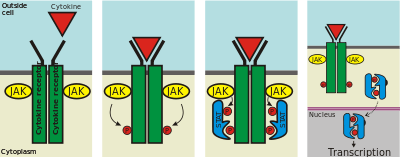JAK-STAT signaling pathway
The JAK-STAT signaling pathway transmits information from extracellular chemical signals to the nucleus resulting in DNA transcription and expression of genes involved in immunity, proliferation, differentiation, apoptosis and oncogenesis. The JAK-STAT signalling cascade consists of three main components: a cell surface receptor, a Janus kinase (JAK) and two Signal Transducer and Activator of Transcription (STAT) proteins.[1] Disrupted or dysregulated JAK-STAT functionality can result in immune deficiency syndromes and cancers.[1]
Mechanism

The binding of various ligands, usually cytokines, such as interferon, interleukin, and growth factors to cell surface receptors, activate associated JAKs, increasing their kinase activity.[2] Activated JAKs then phosphorylate tyrosine residues on the receptor, creating binding sites for proteins possessing SH2 domains. SH2 domain containing STATs are recruited to the receptor where they are also tyrosine-phosphorylated by JAKs. These activated STATs form hetero- or homodimers and translocate to the cell nucleus where they induce transcription of target genes.[3] STATs may also be tyrosine-phosphorylated directly by receptor tyrosine kinases, such as the epidermal growth factor receptor, as well as by non-receptor (cytoplasmic) tyrosine kinases such as c-src.
The pathway is negatively regulated on multiple levels. Protein tyrosine phosphatases remove phosphates from cytokine receptors and activated STATs.[3] More recently identified suppressors of cytokine signalling (SOCS) inhibit STAT phosphorylation by binding and inhibiting JAKs or competing with STATs for phosphotyrosine binding sites on cytokine receptors.[4] STATs are also negatively regulated by protein inhibitors of activated STAT (PIAS), which act in the nucleus through several mechanisms.[5] For example, PIAS1 and PIAS3 inhibit transcriptional activation by STAT1 and STAT3, respectively by binding and blocking access to the DNA sequences they recognize.
See also
- Janus kinase inhibitor, a type of Janus kinases-blocking drugs used for cancer therapy.
References
- 1 2 Aaronson DS, Horvath CM (May 2002). "A road map for those who don't know JAK-STAT". Science. 296 (5573): 1653–5. doi:10.1126/science.1071545. PMID 12040185.
- ↑ Brooks, Andrew (2014). "Mechanism of activation of protein kinase JAK2 by the growth hormone receptor". Science. 344 (6185): 1249783. doi:10.1126/science.1249783. PMID 24833397.
- 1 2 Hebenstreit D, Horejs-Hoeck J, Duschl A (2005). "JAK/STAT-dependent gene regulation by cytokines". Drug News Perspect. 18 (4): 243–249. doi:10.1358/dnp.2005.18.4.908658. PMID 16034480. 16034480.
- ↑ Krebs DL, Hilton DJ (2001). "SOCS proteins: negative regulators of cytokine signaling". Stem Cells. 19 (5): 378–87. doi:10.1634/stemcells.19-5-378. PMID 11553846.
- ↑ Shuai K (2006). "Regulation of cytokine signaling pathways by PIAS proteins". Cell Research. 16 (2): 196–202. doi:10.1038/sj.cr.7310027. PMID 16474434. 16474434.
Further reading
- Schroder K, Hertzog PJ, Ravasi T, Hume DA (February 2004). "Interferon-gamma: an overview of signals, mechanisms and functions". J. Leukoc. Biol. 75 (2): 163–89. doi:10.1189/jlb.0603252. PMID 14525967.
- O'Shea JJ, Gadina M, Schreiber RD (April 2002). "Cytokine signaling in 2002: new surprises in the Jak/Stat pathway". Cell. 109 (Suppl): S121–31. doi:10.1016/S0092-8674(02)00701-8. PMID 11983158.